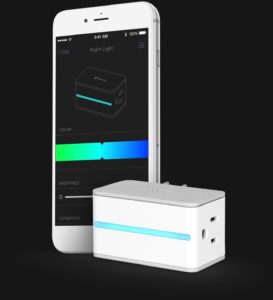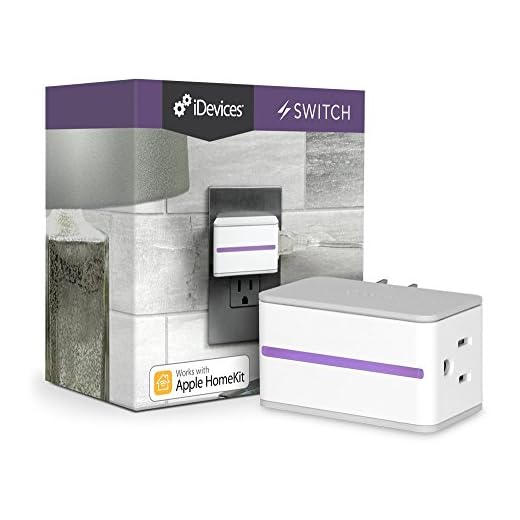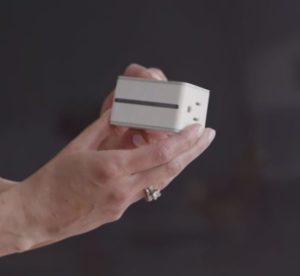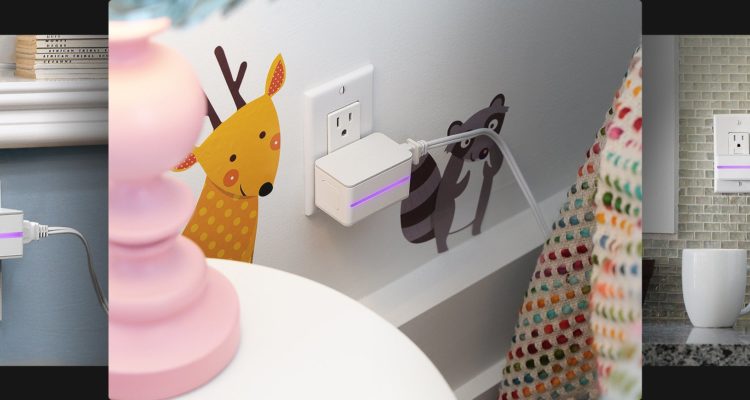Smart plugs are everywhere these days. Dozens of companies have flooded the market with simple designs and the basic array of features. But few offer support for Apple Homekit users. That’s where the Switch from iDevices steps in.
The iDevices Switch Smart Plug comes in at just under $30 which is right in line with their competitors. But besides HomeKit support, they differentiate themselves with an innovative design and advanced features that are hard to come by. It all leads to this being one of the best smart plugs on the market for Apple-centric users.
Innovative Design with Nightlight
With smart plugs taking a similar path in their design, it’s nice to see a company willing to take chances. The Switch does that by placing their 3-prong socket on the right side of the device. This might seem odd, but it has a purpose. It prevents the plug from looking like an unsightly eyesore protruding from the wall. This is especially beneficial in a kitchen where the plugs sit above the counter. It may make it awkward when using on a power strip, but when plugged directly into the wall, it just feels like a better choice.
 Without a socket on the front, the iDevices Switch can double as an attractive nightlight. An LED light strip runs across the middle where the brightness and color can be controlled through your phone. For it’s small size, the light surprisingly puts out a decent amount of light. A manual power button is located on the left side for when the internet is down.
Without a socket on the front, the iDevices Switch can double as an attractive nightlight. An LED light strip runs across the middle where the brightness and color can be controlled through your phone. For it’s small size, the light surprisingly puts out a decent amount of light. A manual power button is located on the left side for when the internet is down.
At 1.57″ by 2.71″, the Switch will not block the adjacent socket. With a depth of 1.65″, it does protrude a bit more than other smart plugs, although that’s offset by the socket placement on the side. The company states it can handle up to 1800W which should be enough for a window A/C unit or space heater. The plug should only be used indoors. The iDevices Outdoor Switch is their option for outside.
Setup can be done in two ways. If you’re an Apple HomeKit user, simply plug it in, open the Home app, and add an accessory. You’ll need to scan the code that comes in the booklet. It was one of the easiest setups I’ve come across. For non-HomeKit users, you’ll need to download the iDevices app for either iOS or Android. Setup requires a few more steps through their app but I didn’t have any issues. It’s worth noting that you do need their app for firmware updates (although I suppose you could uninstall it right after).

Plenty of Features Including Energy Monitoring
Controlling the plug through either the Home or iDevices app is basic. You of course have the option to turn on and off the switch remotely. You’ll also be able to adjust the brightness of the nightlight and change its color. There was virtually no lag when utilizing these functions.
Typically apps struggle to match Apple’s Home app, but this one held its own. It has an intuitive interface that makes it easy to control all your iDevice gadgets in one place (they sell wall outlets, wall switches, and even a thermostat). You can group plugs together, label rooms, and schedule them to turn on and off at specific times. If you have other HomeKit devices, you can schedule “scenes” which allow multiple actions to take place at once. For instance, you could create a scene called “Wake Up” which would turn on the coffee maker connected to your iDevices plug, along with adjusting your thermostat and turning on the hallway light.
A bonus feature I’m always happy to see is energy monitoring. This is typically found in more expensive models with bulkier designs (like the Wemo Insight). So it’s nice to see it offered here on a more budget-friendly smart plug. This requires using their app and will show you how much power your appliance is using. You’ll be able to track the average energy consumption on a daily, weekly, monthly, or yearly basis. If you enter the cost per kWh you pay, it’ll even give you an estimate on how costly a specific device in your home is. Comparing the numbers from this plug to a professional energy monitor tool, it was fairly accurate. LED bulbs were within a single watt while more power hungry appliances were off by maybe 2-3%.
Perhaps the only hitch I ran into with the plug was occasional connectivity issues. This was nowhere near as widespread as the problems we encountered in our iHome iSP6X Smart Plug review, but still an annoyance. This was almost always remedied by power-cycling the device by unplugging it and plugging it back in.
Siri is Great, Alexa Not so Much
When it comes to voice controls, the iDevices Switch really shines on iOS. Asking Siri to turn on and off the plug works flawlessly and there is minimal delay. Outside of that, they do offer support for Amazon Alexa and Google Home users. Unfortunately, the good vibes we had with Siri didn’t carry over.
 Connecting to both Amazon Alexa and Google Home involves a few extra steps. It requires logging into your Google or Amazon account and linking your iDevices account to it. This is a routine task but it required multiple attempts on both. After linking accounts, voice commands did work with Alexa and Google Assistant. Unfortunately, Alexa seemed to struggle to keep in contact with the plug. Every few days it seems I’d have to reset the plug so that my Echo Dot could control it.
Connecting to both Amazon Alexa and Google Home involves a few extra steps. It requires logging into your Google or Amazon account and linking your iDevices account to it. This is a routine task but it required multiple attempts on both. After linking accounts, voice commands did work with Alexa and Google Assistant. Unfortunately, Alexa seemed to struggle to keep in contact with the plug. Every few days it seems I’d have to reset the plug so that my Echo Dot could control it.
Besides the big 3, the Switch is not compatible with any other service. That means no Samsung SmartThings, Nest, or IFTTT. Things that the TP-Link Mini Smart Plug and the iHome iSP6X provide support for (although TP-Link is not HomeKit compatible). This could always change down the road with a software update, but I get the feeling this company is putting most of their effort into the Apple ecosystem.
Great for Apple HomeKit Users
The iDevices Switch Smart Plug hits it out of the park when it comes to Apple. It seamlessly integrates into your home’s existing ecosystem and can be controlled with ease using Siri or the Home app. When you venture outside there, it starts to struggle and there are better options.
For Apple HomeKit users, this plug runs neck and neck with the Wemo Mini Smart Plug in terms of value. It sits right near the top of our best smart plugs for HomeKit users. The Elgato Eve Energy is also a great choice but at a much higher price. If you like the energy monitoring capability, the side outlet, and customizable nightlight, go with this unit. If those don’t move the needle, the Wemo Mini is compatible with more services (SmartThings, IFTTT, Nest) and a bit more reliable. Either way, you’re getting a really good smart plug.

